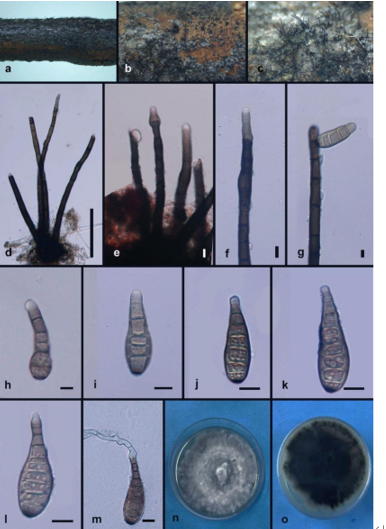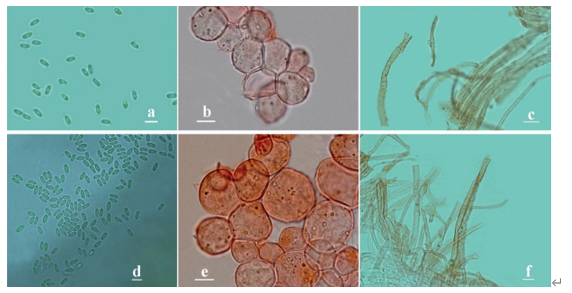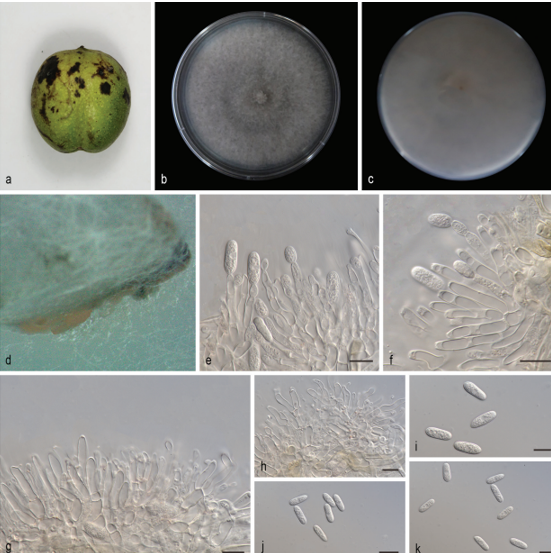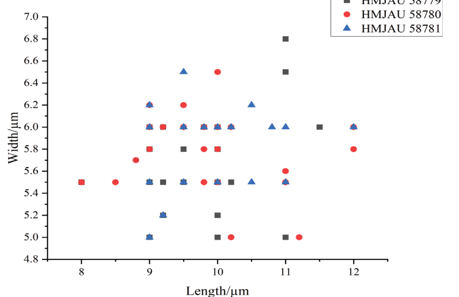Chapsa murioelongata M.Z. Dou & M. Li, sp. nov. 2021
Fungal Names: FN 570754
Holotype:
Morphological description
Sexual morph: Thallus corticolous, crustose, olive-grey, surface dull, smooth to uneven, ecorticate. Apothecia erumpent, dispersed or two to four aggregated, rounded, 1–3 mm diam.; thalline margin lobed with white felt-like inner s strongly backward curved; disc flesh-coloured, covered by thick, white pruina. Exciple 80–105 μm wide laterally, dark brown; epihymenium 20–40 μm high, with coarse greyish granules; hymenium clear, 110–170 μm high, non-amyloid; hypothecium colourless, 10–30 μm high; paraphyses simple, tips unbranched; periphysoides present, 5–30 μm long. Asci 4–6 (8)-spored, clavate, 100–120 × 35–50 μm; ascospores hyaline, bacillary with rounded to subacute ends, submuriform with 20–25 transverse septa and 0–2 longitudinal septa per segment, 75–105 × 9.5–16 μm, non-halonate, I-. Pycnidia not observed
Asexual morph:Undetermined.
Cultures:
Habitat: On the bark in semi-exposed forest of Hainan Province.
Distribution: . China. Hainan Province: Changjiang County, Bawangling Nature Reserve, Yajia Scenic Area, 10°04'54"N, 109°07'04"E, alt. 810 m, on bark, 08 Dec 2019, Y. H. Ju HN19167 (LCUF); China. Hainan Province: Lingshui County, Diaoluo Mountain, 18°43'35"N, 109°52'02"E, alt. 900 m, on bark, 14 Dec 2019, M. Li HN19682 (LCUF) (GenBank MW009103 for ITS and MW010269 for LSU).
GenBank Accession: its MW009102; nulsu MW01027 its MW009103 ; nulsuMW0102691.
Notes: . Chapsa murioelongata is characterised by its olive-grey thallus; white pruinose discs; distinct periphysoids; clear hymenium; 4–8-spored asci; submuriform ascospores with 20–25 transverse septa and 0–2 longitudinal septa per segment. Chapsa microspora Kalb, C. asteliae (Kantvilas & Vězda) Mangold, Astrochapsa elongata Poengs. & Lumbsch and C. patens are morphologically similar to the new species. Chapsa microspora can be distinguished from C. murioelongata by the smaller apothecia (0.6–1.2 mm diam.), transversely septate and smaller ascospores (7–9 × 4 μm) (Lumbsch et al. 2011). Chapsa asteliae differs in amyloid and shorter ascospores (30–80 μm) (Kantvilas and Vězda 2000; Mangold 2008). Astrochapsa elongata differs from C. murioelongata in having shorter ascospores (40–65 μm) and less longitudinal septa per segment (0–1) (Poengsungnoen et al. 2019). Chapsa patens differs from C. murioelongata chiefly in the single-spored asci and broader ascospores (22–35 μm) (Frisch et al. 2006). Blast searches of nuLSU sequences indicate Chapsa murioelongata has close affinities with C. patens (98.36% identity), C. wolseleyana (95.63% identity), C. leprocarpa (91.97% identity) and C. indica (90.81% identity), so all these species were included in the phylogenetic analyses. Chapsa murioelongata was well separated from any other species in the tree and strongly supported as the monophyletic (PP = 1; ML = 100%).
Reference: [1] Dou, M. Z. , Li, M. , & Jia, Z. F. . (2021). New species and records of chapsa (graphidaceae) in china.
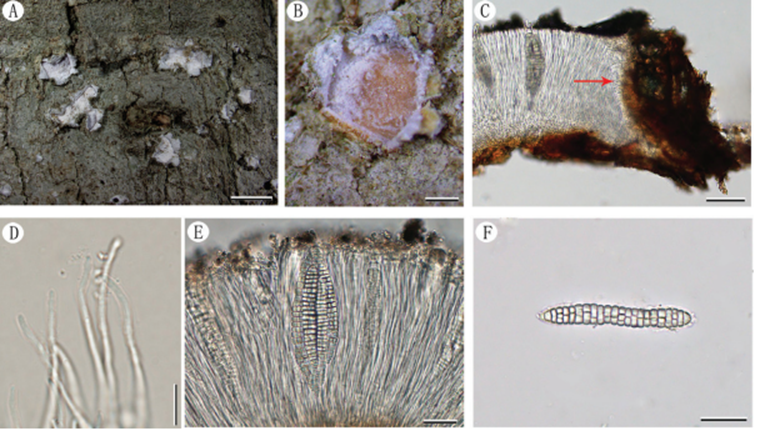 Chapsa murioelongata (LCUF HN19222) A habit of thallus with apothecia at different developmental stages B apothecium (the pruina of the disc partly scraped off) C section of apothecium with periphysoids (direction of arrow) D paraphyses E an ascus containing six ascospores F ascospore. Scale bars: 3 mm (A); 0.5 mm (B); 50 μm (C); 8 μm (D); 30 μm (E); 25 μm
Chapsa murioelongata (LCUF HN19222) A habit of thallus with apothecia at different developmental stages B apothecium (the pruina of the disc partly scraped off) C section of apothecium with periphysoids (direction of arrow) D paraphyses E an ascus containing six ascospores F ascospore. Scale bars: 3 mm (A); 0.5 mm (B); 50 μm (C); 8 μm (D); 30 μm (E); 25 μm


